Lunar Eclipse

Lunar Eclipse
On January 20-21, be ready for a series of firsts. It’s the first full moon of 2019, and the first lunar eclipse of 2019 (and this is an eclipse-heavy year, with five eclipses, including two lunar eclipses in 2019; read more). Plus, it’s the year’s first supermoon, meaning the moon is nearly at its closest to Earth for this month, as the eclipse takes place.
And now … a single sad last thing. This will be the last total lunar eclipse to grace Earth’s sky until May 26, 2021.
The January 20-21 total eclipse of the moon lasts for somewhat more than one hour, and is preceded and followed by a partial umbral eclipse, each time persisting for over an hour. The whole umbral eclipsefrom start to finish has a duration of a little more than 3 1/3 hours, and can be viewed from North and South America, Greenland, Iceland, Europe, northern and western Africa plus the Arctic region of the globe.
Additionally, a penumbral lunar eclipse takes place before and after the umbral lunar eclipse. However, a penumbral lunar eclipse is so faint that many people won’t even notice it while it is happening. In our post, we only give the times of the moon passing through the Earth’s umbra – dark, cone-shaped shadow. See the diagram below.
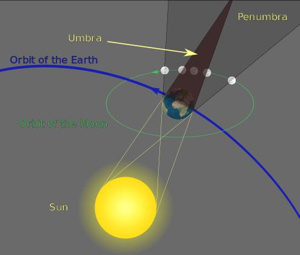
In any umbral lunar eclipse, the moon always passes through Earth’s very light penumbral shadow before and after its journey through the dark umbra.
The worldwide map below shows where the eclipse is visible worldwide, and, beneath the map, we give the local times for the eclipse at North American and U.S. time zones. If you want to know more specifically when (or if) this eclipse is visible from your part of the world, try one of these sources:
Total lunar eclipse on January 20-21 via TimeandDate.com
Total lunar eclipse (put in your time zone) via Hermit Eclipse
At the eastern/western fringes of the viewing area, you can only see the beginning or ending stages of this eclipse. For instance, from the Middle East and eastern/southern Africa, you might glimpse the beginning of the partial eclipse low in the western sky shortly before the sun rises and the moon sets on January 21. At the other extreme -from the temperate regions of northeastern Siberia – you may catch the final stages of the partial eclipse low in the eastern sky for a short while after the sun sets and the moon rises on January 21.
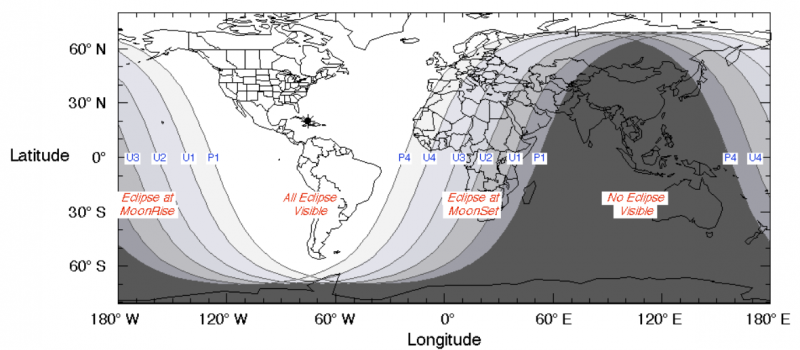
At greatest eclipse, the totally eclipsed moon will be at zenith (straight overhead) over western Cuba, where it’s around midnight local time on January 21, 2019 (or January 21 at 05:12 Universal Time). Anyone living appreciably west (left) of this spot (most of North America, Hawaii) will see the moon at greatest eclipse on the evening of January 20. On the other hand, anyone living appreciably east (right) of this spot (Europe and Africa) will see the moon at its greatest eclipse in their western sky on the morning of January 21.
Here are the eclipse times for Canadian and U.S. time zones:
Eastern Time
Partial umbral eclipse begins: 10:34 p.m. (January 20, 2019)
Total lunar eclipse begins: 11:41 p.m. (January 20, 2019)
Greatest eclipse: 12:12 a.m. (January 21, 2019)
Total lunar eclipse ends: 12:43 a.m. (January 21, 2019)
Partial umbral eclipse ends: 1:51 a.m. (January 21, 2019)
Central Time
Partial umbral eclipse begins: 9:34 p.m. (January 20, 2019)
Total lunar eclipse begins: 10:41 p.m. (January 20, 2019)
Greatest eclipse: 11:12 p.m. (January 20, 2019)
Total lunar eclipse ends: 11:43 p.m. (January 20, 2019)
Partial umbral eclipse ends: 12:51 a.m. (January 21, 2019)
Mountain Time
Partial umbral eclipse begins: 8:34 p.m. (January 20, 2019)
Total lunar eclipse begins: 9:41 p.m. (January 20, 2019)
Greatest eclipse: 10:12 p.m. (January 20, 2019)
Total lunar eclipse ends: 10:43 p.m. (January 20, 2019)
Partial umbral eclipse ends: 11:51 p.m. (January 20, 2019)
Pacific Time
Partial umbral eclipse begins: 7:34 p.m. (January 20, 2019)
Total lunar eclipse begins: 8:41 p.m. (January 20, 2019)
Greatest eclipse: 9:12 p.m. (January 20, 2019)
Total lunar eclipse ends: 9:43 p.m. (January 20, 2019)
Partial umbral eclipse ends: 10:51 p.m. (January 20, 2019)
Alaskan Time
Partial umbral eclipse begins: 6:34 p.m. (January 20, 2019)
Total lunar eclipse begins: 7:41 p.m. (January 20, 2019)
Greatest eclipse: 8:12 p.m. (January 20, 2019)
Total lunar eclipse ends: 8:43 p.m. (January 20, 2019)
Partial umbral eclipse ends: 9:51 p.m. (January 20, 2019)
Hawaiian Time
Moon partially eclipsed at moonrise: 6:07 p.m. (January 20, 2019)
Total lunar eclipse begins: 6:41 p.m. (January 20, 2019)
Greatest eclipse: 7:12 p.m. (January 20, 2019)
Total lunar eclipse ends: 7:43 p.m. (January 20, 2019)
Partial umbral eclipse ends: 8:51 p.m. (January 20, 2019)
The moon will pass through the northern half of the Earth’s shadow, as depicted on the diagram below, to present a total eclipse for a period of 62 minutes. However, when the moon travels more deeply into the Earth’s shadow, it results in an even longer total lunar eclipse. For instance, exactly six lunar months (six full moons) ago – on July 27, 2018 – the full moon passed almost exactly dead center through the Earth’s shadow, to stage a total eclipse lasting 1 hour and 43 minutes. That July 27, 2018, production gave us the longest total lunar eclipse of the 21st century (2001 to 2100).
The moon travels from west to east across the Earth’s shadow. On the night of January 20-21, 2019, the moon’s south pole swings most closely to the center of the umbra, so we expect the southern half of the moon to appear darker than the northern half during the total eclipse.
The lunar disk often exhibits a coppery color during a total lunar eclipse. Although the moon is completely immersed in the Earth’s dark shadow, the Earth’s atmosphere refracts (or bends) sunlight and the longer wavelengths of light (red and orange) pass onward to fall on the moon’s face. The dispersed light from all of the world’s sunrises and sunsets softly illuminates the totally eclipsed moon. Actually, if you were on the moon, looking back on Earth, you’d see a total eclipse of the sun.
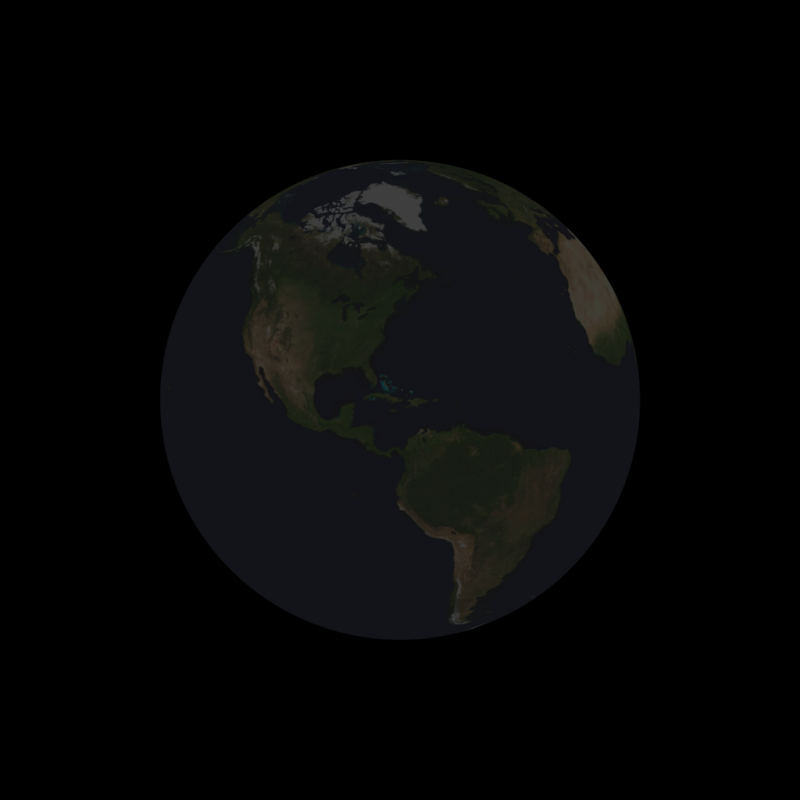
If you were on the moon at greatest eclipse (Januray 21, 2019, at 05:12 Universal Time), you’d actually see a total eclipse of the sun. Image via the U.S. Naval Observatory.
Only at full moon is a lunar eclipse possible. That’s because it’s the only time that the moon can be directly opposite the sun in Earth’s sky and swing through the Earth’s shadow. Yet, a lunar eclipse doesn’t happen at every full moon because the full moon, depending upon the month, can swing anywhere from five degrees (10 moon-diameters) north or south of the Earth’s shadow.
The next five full moons in February, March, April, May and June 2019 will veer to the north of the Earth’s shadow until the moon partially clips the Earth’s shadow on July 16. 2019.
After that, the following five full moons in August, September, October, November and December 2019 will swerve to the south of the Earth’s shadow, until the penumbral lunar eclipse of January 10, 2020.
Day and night sides of Earth at greatest eclipse (January 21 at 05:12 Universal Time). The shadow line at left represents sunset January 20 and the shadow line at right depicts sunrise January 21, 2019. Image via the U.S. Naval Observatory.
There will be a total of four lunar eclipses in the year 2020 (January 10, June 5, July 5 and November 30, 2020), but all these lunar eclipses will be hard-to-see penumbral eclipses. If you’re in a position to witness tonight’s total eclipse of the moon, by all means do so. The next total lunar eclipse won’t happen until May 26, 2021.
lunar eclipse occurs when the Moon passes directly behind Earth and into its shadow.This can occur only when the Sun, Earth, and Moon are exactly or very closely aligned (in syzygy), with Earth between the other two. A lunar eclipse can occur only on the night of a full moon. The type and length of a lunar eclipse depend on the Moon's proximity to either node of its orbit.
During a total lunar eclipse, Earth completely blocks direct sunlight from reaching the Moon. The only light reflected from the lunar surface has been refracted by Earth's atmosphere. This light appears reddish for the same reason that a sunset or sunrise does: the Rayleigh scattering of bluer light. Due to this reddish color, a totally eclipsed Moon is sometimes called a blood moon.
Unlike a solar eclipse, which can be viewed only from a certain relatively small area of the world, a lunar eclipse may be viewed from anywhere on the night side of Earth. A total lunar eclipse lasts a few hours, whereas a total solar eclipse lasts only a few minutes as viewed from any given place, due to the smaller size of the Moon's shadow. Also unlike solar eclipses, lunar eclipses are safe to view without any eye protection or special precautions, as they are dimmer than the full Moon.
For the date of the next eclipse, see the section Recent and forthcoming lunar eclipses.
Types of lunar eclipse

A schematic diagram of the shadow cast by Earth. Within the umbra, the central region, the planet totally shields direct sunlight. In contrast, within the penumbra, the outer portion, the sunlight is only partially blocked. (Neither the Sun, Moon, and Earth sizes nor the distances between the bodies are to scale.)

A total penumbral lunar eclipse dims the Moon in direct proportion to the area of the Sun's disk covered by Earth. This comparison of the Moon (within the southern part of Earth's shadow) during the penumbral lunar eclipse of January 1999 (left) and the Moon outside the shadow (right) shows this slight darkening.
Earth's shadow can be divided into two distinctive parts: the umbra and penumbra. Earth totally occludes direct solar radiationwithin the umbra, the central region of the shadow. However, since the Sun's diameter appears about one-quarter of Earth's in the lunar sky, the planet only partially blocks direct sunlight within the penumbra, the outer portion of the shadow.
A penumbral lunar eclipse occurs when the Moon passes through Earth's penumbra. The penumbra causes a subtle dimming of the lunar surface. A special type of penumbral eclipse is a total penumbral lunar eclipse, during which the Moon lies exclusively within Earth's penumbra. Total penumbral eclipses are rare, and when these occur, the portion of the Moon closest to the umbra may appear slightly darker than the rest of the lunar disk.
A partial lunar eclipse occurs when only a portion of the Moon enters Earth's umbra, while a total lunar eclipse occurs when the entire Moon enters the planet's umbra. The Moon's average orbital speed is about 1.03 km/s (2,300 mph), or a little more than its diameter per hour, so totality may last up to nearly 107 minutes. Nevertheless, the total time between the first and the last contacts of the Moon's limb with Earth's shadow is much longer and could last up to four hours.
The relative distance of the Moon from Earth at the time of an eclipse can affect the eclipse's duration. In particular, when the Moon is near apogee, the farthest point from Earth in its orbit, its orbital speed is the slowest. The diameter of Earth's umbra does not decrease appreciably within the changes in the Moon's orbital distance. Thus, the concurrence of a totally eclipsed Moon near apogee will lengthen the duration of totality.
A central lunar eclipse is a total lunar eclipse during which the Moon passes through the centre of Earth's shadow, contacting the antisolar point. This type of lunar eclipse is relatively rare.
Selenelion

A view of the October 2014 lunar eclipse from Minneapolis, with the setting and partially eclipsed Moon appearing squashed just above the horizon just after sunrise (seen as sunlight shining on the tree in the right image.

A selenelion or selenehelion occurs when both the Sun and an eclipsed Moon can be observed at the same time. This can occur only just before sunset or just after sunrise, when both bodies will appear just above the horizon at nearly opposite points in the sky. This arrangement has led to the phenomenon being also called a horizontal eclipse.
Typically, a number of high ridges undergoing sunrise or sunset can view it. Although the Moon is in Earth's umbra, both the Sun and an eclipsed Moon can be simultaneously seen because atmospheric refraction causes each body to appear higher in the sky than their true geometric positions.
Timing

As viewed from Earth, the Earth’s shadow can be imagined as two concentric circles. As the diagram illustrates, the type of lunar eclipse is defined by the path taken by the Moon as it passes through Earth’s shadow. If the Moon passes through the outer circle but does not reach the inner circle, it is a penumbral eclipse; if only a portion of the moon passes through the inner circle, it is a partial eclipse; and if entire Moon passes through the inner circle at some point, it is a total eclipse.
Contact points relative to the Earth's umbral and penumbral shadows, here with the Moon near is descending node
The timing of total lunar eclipses are determined by its contacts:
- P1 (First contact): Beginning of the penumbral eclipse. Earth's penumbra touches the Moon's outer limb.
- U1 (Second contact): Beginning of the partial eclipse. Earth's umbra touches the Moon's outer limb.
- U2 (Third contact): Beginning of the total eclipse. The Moon's surface is entirely within Earth's umbra.
- Greatest eclipse: The peak stage of the total eclipse. The Moon is at its closest to the center of Earth's umbra.
- U3 (Fourth contact): End of the total eclipse. The Moon's outer limb exits Earth's umbra.
- U4 (Fifth contact): End of the partial eclipse. Earth's umbra leaves the Moon's surface.
- P4 (Sixth contact): End of the penumbral eclipse. Earth's penumbra no longer makes contact with the Moon.
Danjon scale
The following scale (the Danjon scale) was devised by André Danjon for rating the overall darkness of lunar eclipses:
- L=0: Very dark eclipse. Moon almost invisible, especially at mid-totality.
- L=1: Dark eclipse, gray or brownish in coloration. Details distinguishable only with difficulty.
- L=2: Deep red or rust-colored eclipse. Very dark central shadow, while outer edge of umbra is relatively bright.
- L=3: Brick-red eclipse. Umbral shadow usually has a bright or yellow rim.
- L=4: Very bright copper-red or orange eclipse. Umbral shadow is bluish and has a very bright rim.
Lunar versus solar eclipse

A solar eclipse occurs in the daytime at new moon, when the Moon is between Earth and the Sun, while a lunar eclipse occurs at night at full moon, when Earth passes between the Sun and the Moon.

The Moon does not completely darken as it passes through the umbra because Earth's atmosphere refractssunlight into the shadow cone.
There is often confusion between a solar eclipse and a lunar eclipse. While both involve interactions between the Sun, Earth, and the Moon, they are very different in their interactions.
Lunar eclipse appearance

In a lunar eclipse, the Moon often passes through two regions of Earth's shadow: an outer penumbra, where direct sunlight is dimmed, and an inner umbra, where indirect and much dimmer sunlight refracted by Earth's atmosphere shines on the Moon, leaving a reddish color. This can be seen in different exposures of a partial lunar eclipse, for example here with exposures of 1/80, 2/5, and 2 seconds.
The Moon does not completely darken as it passes through the umbra because of the refraction of sunlight by Earth's atmosphereinto the shadow cone; if Earth had no atmosphere, the Moon would be completely dark during the eclipse.[6] The reddish coloration arises because sunlight reaching the Moon must pass through a long and dense layer of Earth's atmosphere, where it is scattered. Shorter wavelengths are more likely to be scattered by the air molecules and small particles; thus, the longer wavelengths predominate by the time the light rays have penetrated the atmosphere. Human vision perceives this resulting light as red. This is the same effect that causes sunsets and sunrisesto turn the sky a reddish color. An alternative way of conceiving this scenario is to realize that, as viewed from the Moon, the Sun would appear to be setting (or rising) behind Earth.
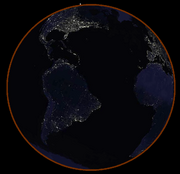
From the Moon, a lunar eclipse would show a ring of reddish-orange light surrounding a silhouetted Earth in the lunar sky.
The amount of refracted light depends on the amount of dust or clouds in the atmosphere; this also controls how much light is scattered. In general, the dustier the atmosphere, the more that other wavelengths of light will be removed (compared to red light), leaving the resulting light a deeper red color. This causes the resulting coppery-red hue of the Moon to vary from one eclipse to the next. Volcanoes are notable for expelling large quantities of dust into the atmosphere, and a large eruption shortly before an eclipse can have a large effect on the resulting color.
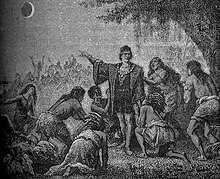
Christopher Columbus predicted a lunar eclipse.
Lunar eclipse in culture
Several cultures have myths related to lunar eclipses or allude to the lunar eclipse as being a good or bad omen. The Egyptians saw the eclipse as a sow swallowing the moon for a short time; other cultures view the eclipse as the Moon being swallowed by other animals, such as a jaguar in Mayan tradition, or a three legged toad in China. Some societies thought it was a demon swallowing the Moon, and that they could chase it away by throwing stones and curses at it. The Greeks were ahead of their time when they said the Earth was round and used the shadow from the lunar eclipse as evidence. Some Hindus believe in the importance of bathing in the Ganges River following an eclipse because it will help to achieve salvation.
Incans
Similarly to the Mayans, the Incans believed that lunar eclipses occurred when a jaguar would eat the Moon, which is why a blood moon looks red. The Incans also believed that once the jaguar finished eating the Moon, it could come down and devour all the animals on Earth, so they would take spears and shout at the Moon to keep it away.
Mesopotamians
The ancient Mesopotamians believed that a lunar eclipse was when the Moon was being attacked by seven demons. This attack was more than just one on the Moon, however, for the Mesopotamians linked what happened in the sky with what happened on the land, and because the king of Mesopotamia represented the land, the seven demons were thought to be also attacking the king. In order to prevent this attack on the king, the Mesopotamians made someone pretend to be the king so they would be attacked instead of the true king. After the lunar eclipse was over, the substitute king was made to disappear (possibly by poisoning).
Chinese
In some Chinese cultures, people would ring bells to prevent a dragon or other wild animals from biting the Moon. In the nineteenth century, during a lunar eclipse, the Chinese navy fired its artillery because of this belief.During the Zhou Dynasty in the Book of Songs, the sight of a red Moon engulfed in darkness was believed to foreshadow famine or disease.
Blood moon
Certain lunar eclipses have been referred to as "blood moons" in popular articles but this is not a scientifically-recognized term. This term has been given two separate, but overlapping, meanings.
The first, and simpler, meaning relates to the reddish color a totally eclipsed Moon takes on to observers on Earth. As sunlightpenetrates the atmosphere of Earth, the gaseous layer filters and refracts the rays in such a way that the green to violet wavelengths on the visible spectrum scattermore strongly than the red, thus giving the Moon a reddish cast.
The second meaning of "blood moon" has been derived from this apparent coloration by two fundamentalist Christian pastors, Mark Blitz and John Hagee. They claimed that the 2014–15 "lunar tetrad" of four lunar eclipses coinciding with the feasts of Passover and Tabernacles matched the "moon turning to blood" described in the Book of Joel of the Hebrew Bible. This tetrad was claimed to herald the Second Coming of Christ and the Rapture as described in the Book of Revelation on the date of the first of the eclipses in this sequence on April 15, 2014.
Occurrence
 This multi-exposure sequence shows the August 2017 lunar eclipse visible from the ESO headquarters.
This multi-exposure sequence shows the August 2017 lunar eclipse visible from the ESO headquarters.

This collage shows the transitional stages of a lunar eclipse.


At least two lunar eclipses and as many as five occur every year, although total lunar eclipses are significantly less common. If the date and time of an eclipse is known, the occurrences of upcoming eclipses are predictable using an eclipse cycle, like the saros.












0 Comments